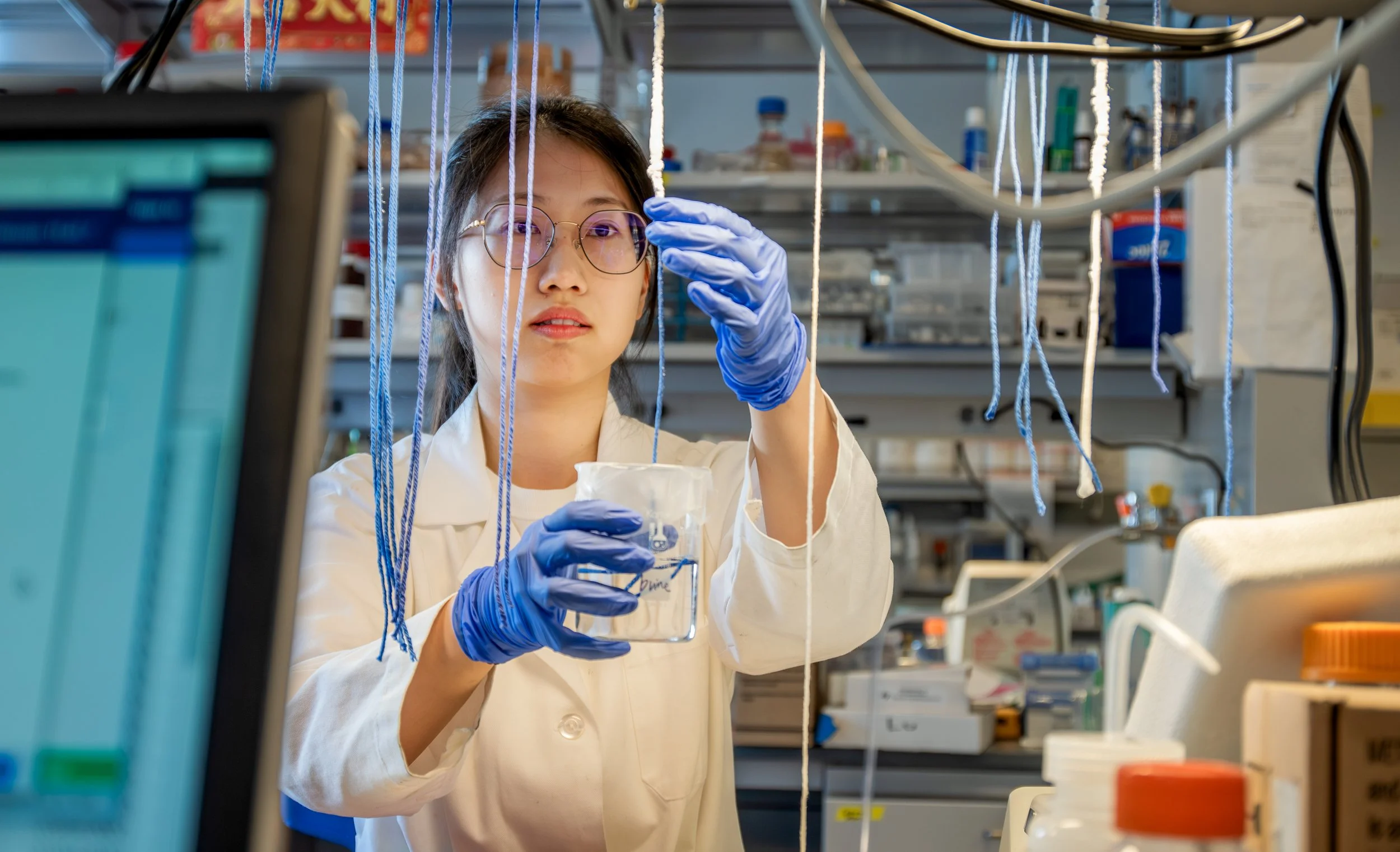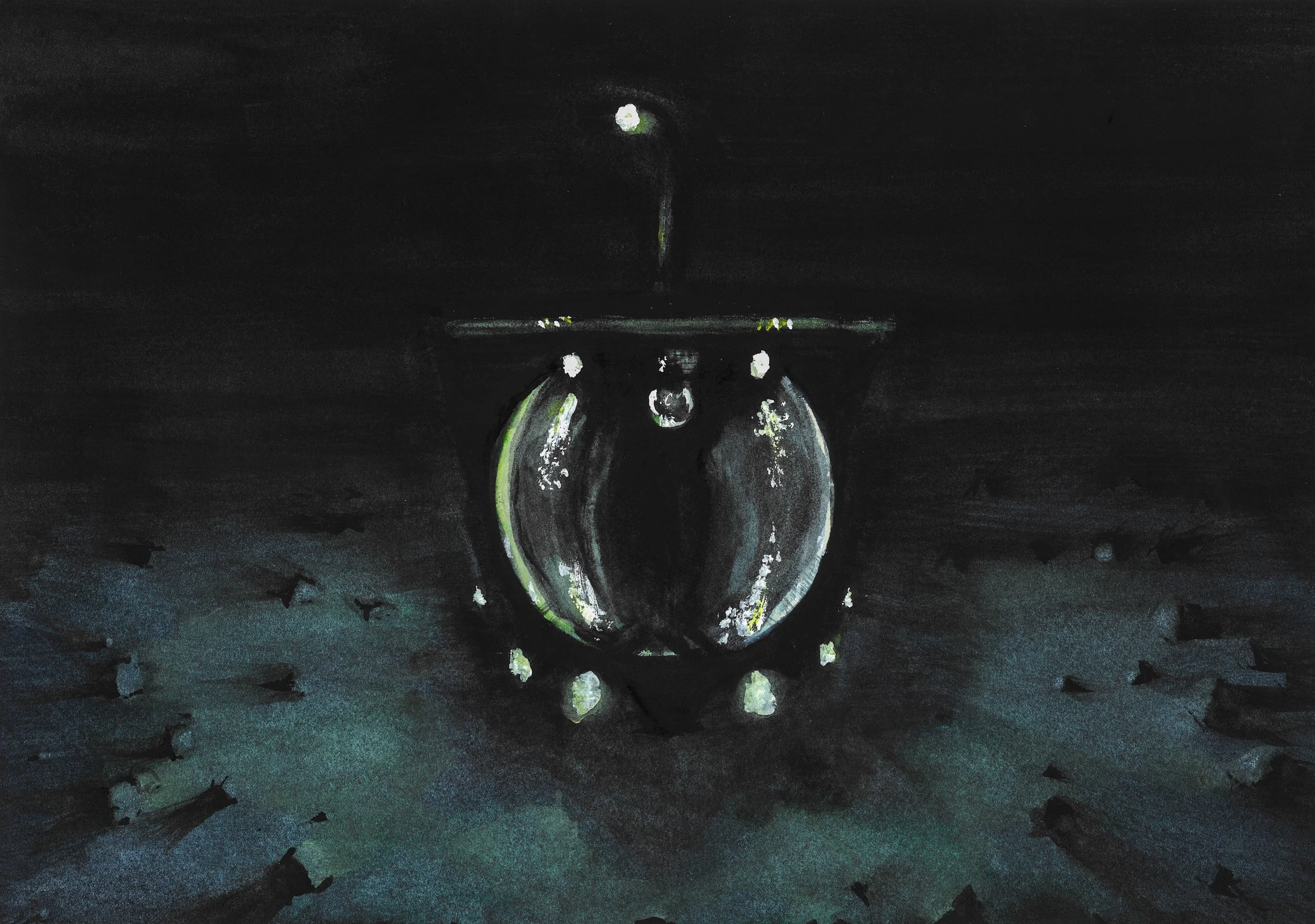A New Thread in Lithium Extraction
Fiber braids offer a more sustainable way to concentrate lithium
Scientists at Princeton University’s Andlinger Center for Energy and the Environment have recently published research on extracting lithium from brine using strings of fiber. Image credit: Bumper DeJesus, Andlinger Center for Energy and the Environment
by Amy Elisabeth Moore
January 30, 2024
Lightweight lithium powers phones, computers, and electric vehicles. But its potential to electrify entire industries and provide grid storage for renewable energy intensifies the search for clean ways to extract the element.
The United States imports most of its processed lithium from Argentina and Chile, and sources most of its battery-grade refined lithium from China. The 2022 Inflation Reduction Act, however, directed more than $250 billion toward clean energy, incentivizing researchers to develop domestic lithium recovery methods with more stringent environmental and social justice protections. Last year, the Environmental Protection Agency ramped up electric vehicle sales goals to 67% of light-duty cars and 25% of heavy-duty trucks by 2030. Doing so would require quadrupling lithium production.
Researchers at Princeton University’s Andlinger Center for Energy and the Environment unveiled what could be a revolutionary lithium recovery method in a paper published in Nature Water in September 2023. Their method purports to separate highly concentrated lithium from brines, using a biodegradable material without additional, toxic chemicals.
In a lab, the team developed a cellulose-based, porous fiber that relies on capillary action — the same way water travels from a plant’s roots to its leaves — to pull brine up the string. As the water evaporates, it leaves behind concentrated lithium.
A January 2019 aerial view of the Salton Sea in Southern California. The lake is just south of Joshua Tree National Park and is known for its high saline content and surrounding geothermal fields. Image credit: Dick Lyon via Wikimedia Commons (CC BY-SA 4.0), edits by Rachel Lense for The Science Writer
Lithium tumbles among the many salts in brines such as seawater and saline inland lakes like the Salton Sea in Southern California. Beneath the lake’s placid surface, superheated geothermal brines seethe under pressure. For more than 50 years, engineers have tapped these reservoirs to produce energy. Today, teams of scientists are collaborating with companies to recover this lithium. However, the acidic waters pose significant challenges.
The Princeton team’s new technology promises to be greener, cheaper, and faster than conventional lithium extraction methods, such as ore mining and brine ponds that rely on open-air evaporation. An evaporation pond can be as large as a football field and often reflects shades of turquoise. The hues illustrate the various stages of a nearly two-year evaporation process.
To minimize water loss, direct lithium extraction technologies pull the element from brine in a closed-loop system, using absorbent materials or solvents. Brines differ in mineral and salt composition and therefore require precisely calibrated direct extraction methods. Refining companies in China and Argentina, where the practice has been used for more than two decades, continue to finesse dozens of such methods. Still, most require more steps, chemicals, and water to separate and concentrate the lithium than the Princeton team’s fiber method.
The fibers mimic evaporation ponds but use 90% less space, explained study coauthor Sunxiang “Sean” Zheng. Imagine stretching a series of evaporation ponds into a ribbon of river. Then, cut this ribbon into four strands and twist them together. By transforming the large, flat surface into many slim, 3D surfaces, the team shrank the ponds and sped up the process twentyfold.
“It’s basically stacking all the cascade of the ponds together into one, single string,” Zheng said.
From a distance, the twisted fibers resemble fresh spaghetti suspended on drying racks. One end sits in the brine synthesized to reflect actual conditions. Each fiber has a water-shedding exterior and a water-loving core. Water quickly evaporates from the exterior. As the brine climbs up the fibers, the salts — sodium, potassium, and lithium — crystallize on the outer layer.
A Princeton University researcher dips a fibrous string into a lithium brine, which wicks the solution up its length. As the liquid evaporates, concentrated lithium crystallizes on the string. Image credit: Bumper DeJesus, Andlinger Center for Energy and the Environment
The fiber wicks the lithium up to crystalize along the top of the string, leaving behind sodium and potassium. This process produces lithium of higher concentrations than that by conventional methods — 39 times as much from brines and 675 times as much from seawater.
“We’re actually able to manipulate the surface chemistry of that string to have a better control of the crystallization process,” Zheng said. This is crucial for lithium-ion battery production, which requires highly concentrated lithium.
The string design capitalizes on the chemical properties of sodium, potassium, and lithium to separate their crystals naturally. The higher concentrations of less-soluble sodium and potassium crystalize at the bottom, nearer the water source. The lower concentrations of more-soluble lithium crystalize higher up. This separation eliminates the need for hydrochloric acid used in traditional methods.
The most seductive aspect of this new technology, however, may be its simple design and commonplace materials. The fibers are made from cellulose — the insoluble substance that forms cell walls in plants and is used to produce paper or cloth — which “is environmentally friendly, quite cheap, easy to acquire,” Zheng said. This may resonate with frontline communities such as Brawley, a farming town adjacent to the Salton Sea geothermal fields, home to the largest amount of recoverable lithium from brine in the U.S.
However, the porous fiber method may not work with geothermal brines, cautioned Michael McKibben, associate professor emeritus of geology at the University of California, Riverside. He sits on an advisory board for Berkshire Hathaway Energy, currently exploring combined lithium recovery and energy production in the Salton geothermal fields. Berkshire Hathaway and other companies are researching ion-exchange sorbent beads, which precipitate lithium salts out of geothermal brines. This closed-loop process might offer an environmentally sound method for recovering lithium while also producing clean energy — if researchers can develop a cost-effective method for separating lithium from brine.
Geothermal brines “flow at very high rates,” McKibben said. “It’s like drinking from a firehose. Those cellulose fibers are not going to survive under those conditions.”
Another problem is heat. Cellulose is unlikely to withstand 225 degrees Fahrenheit or the high salinity of the Salton geothermal brines, McKibben explained.
“We tried making beads out of cellulose, and the brine broke them down very quickly,” McKibben said.
Cooling the brine might seem a viable solution. But geothermal plants can’t allow the brine to cool too much “because the more it cools, the more silica and iron precipitate out of it,” McKibben said. These precipitates clog injection wells when the leftover brine is re-injected into the ground.
“There’s no way they could cool the brine low enough for that cellulose to survive. It’s just not going to happen,” McKibben said.
But Zheng found that the “extremely durable” cellulose fibers wouldn’t need frequent replacing, and a “high temperature is good for fast evaporation.”
After absorbing the brine, the beads must be rinsed with hydrochloric acid to release the lithium salt, then water to remove the acid. Lithium recovered by the beads is “still pretty diluted, because you need to wash them in a huge amount of fluid again,” Zheng said. In contrast, the fibers don’t require extra processing or water to produce concentrated lithium crystals.
The fiber’s most promising application may be in “flowback water” from gas and oil fields. Considered a waste stream, such water contains many salts and minerals used in agricultural fertilizers or lithium batteries. “It’s easier to deal with those brine waters, because they are already on the ground,” Zheng said, adding that they don’t require energy-intensive pumping. These brines, though still highly saline, will be cooler and less pressurized than brine water in geothermal energy plants.
In August 2023, the Princeton team received additional funds from the National Science Foundation to continue its research. Next, the researchers plan to scale up their fiber technology. The compact strings maximize extraction potential with a small footprint; Zheng envisions a portable prototype in a shipping container that can recover lithium on location. This technology could extract lithium from not only the Salton geothermal fields but also gas and oil fields, which, Zheng pointed out, are “basically everywhere.”
Amy Elisabeth Moore
Amy Elisabeth Moore writes about the environment, clean technology, and energy solutions from Northern California, where she is raising three free-range boys.
Senior Editor: Lindsey Leake
Art Editors: Rachel Lense & Kieran Tuan
Copy Editor: Christopher Graber










